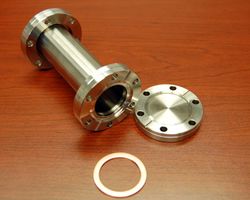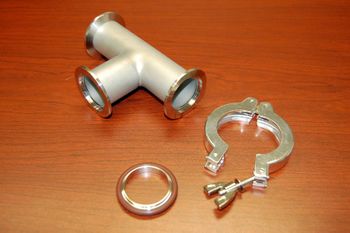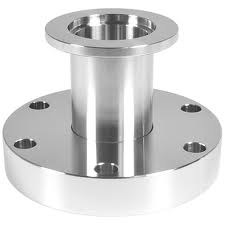Vacuum-Component Assembly: Tips and Procedures
Vacuum Components
The flange on the left is called a CF or Conflat flange. Bolts, nuts and copper gaskets are used to attached components.
The Flange in the middle is called a QF (or KF) Quick Flange. O-rings and clamps are used to attach components.
The rightmost component is a CF-to-KF adapter.
Making CF attachments
When making CF attachments bolts, nuts, washers and copper gaskets are used.
Clean all components in a mild detergent solution in the sonicator. Rinse the sonicated components in distilled water then methanol. Dry components with (e.g.) the heat gun. Inspect the CF knife edges for damage.
Using clean gloves, place a (fresh/new) copper gasket against the knife edge seal of one of two standard CF flanges, preferably the flange most likely to hold and support the gasket from falling. With the gasket in place arrange mating flange with the desired bolt hole orientation. If flanges are fitted with leak test grooves, these should be aligned. With flanges aligned, insert proper size bolt and hand tighten. Washers are typically used on the nut side of the fastener assembly. Repeat this procedure with the remaining bolts.
After hand tightening all bolts, support bolt and turn nut using two closed-end box wrenches. The tightening process must be done gradually in 1/8 to 1/4 turn increments in an alternating crisscross pattern. Continue this incremental tightening until the desired torque ratings have been achieved. Tightening bolts in this fashion will insure a reliable seal with even gasket compression and deformation.




